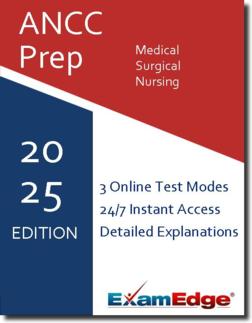ANCC Medical-Surgical Nursing (RN) Practice Tests & Test Prep by Exam Edge - Topics
Based on 37 Reviews
- Real Exam Simulation: Timed questions and matching content build comfort for your ANCC Medical Surgical Nursing test day.
- Instant, 24/7 Access: Web-based ANCC Medical Surgical Nursing practice exams with no software needed.
- Clear Explanations: Step-by-step answers and explanations for your ANCC exam to strengthen understanding.
- Boosted Confidence: Reduces anxiety and improves test-taking skills to ace your ANCC Medical Surgical Nursing (RN).

Understanding the exact breakdown of the ANCC Medical Surgical Nursing test will help you know what to expect and how to most effectively prepare. The ANCC Medical Surgical Nursing has 125 multiple-choice questions The exam will be broken down into the sections below:
| ANCC Medical Surgical Nursing Exam Blueprint | ||
|---|---|---|
| Domain Name | % | Number of Questions |
| Professional Role | 15% | 19 |
| Physiological and Pathophysiological Considerations | 35% | 44 |
| Safety and Infection Control | 15% | 19 |
| Professional Caring and Practice | 20% | 25 |
| Leadership | 15% | 19 |
What Should You Expect on the ANCC Med-Surg Certification Exam?
The ANCC Med-Surg Certification exam isn't about memorizing a textbook. It's about applying your nursing knowledge to real-life situations. Let's break down what you'll face on test day. The exam covers the following broad areas.
Assessment and Diagnosis
This area tests your skills in gathering patient information, identifying potential health issues, and making accurate diagnoses. This means understanding how to interpret lab results, recognize different symptoms, and analyze patient data effectively.
Planning/Implementation and Evaluation
Here, you'll demonstrate your ability to create personalized care plans, implement evidence-based interventions, and assess how patients respond to treatment.
Professional Role
This area evaluates your grasp of nursing ethics, collaboration with other healthcare professionals, and your understanding of your role within the broader healthcare team.
The ANCC may release information about the percentage of questions dedicated to each domain. This can help you allocate your study time strategically.
Scaled Scoring System
The ANCC converts your raw score (the number of questions you get right) to a scaled score from 150 to 500. You need at least a 350 to pass. We don't know their exact formula, but let's say you answer 75% of the questions correctly, that could translate to roughly a 375-400 scaled score
Question Styles
The exam is about proving you can use your nursing knowledge in the real world. Expect some standard multiple-choice questions, but also get ready for ones that make you think critically. You might need to analyze lab results, figure out the best plan for a complex patient, or decide which action to take first in an urgent situation.
The exam will give you a patient scenario and a list of possible nursing interventions. Figure out what's most important to do first, what comes next, and so on.
The best way to get ready for this challenge is with practice tests. Find ones that mimic the ANCC's style as closely as possible. And don't just memorize answers on your practice tests, focus on why one answer is better than another


